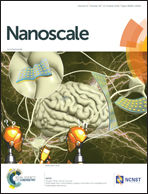Controllable drug release from nano-layered hollow carrier by non-human enzyme †
Abstract
Natural polymers are widely used in biomedical applications because of their numerous effects. Especially, plant-derived natural polymers extracted from cell walls, especially wood, which is abundant, inexpensive and nontoxic to cells, have high mechanical strength to retain their turgor pressure. Plant-derived polymers are also unaffected by enzymes present in the human body, having a strong possibility to create a polymeric structure that releases drugs only exactly where needed. Therefore, plant-derived polymers are suitable for use in drug delivery systems (DDS) as they have durability with few drug leakage issues in the body. Here, to improve drug incorporation and release efficiency, we prepared a multilayer nanofilm from tannic acid (TA) and lignin extracted from plants and wood. We used a strategy involving film degradation by tannase and laccase, which are not present in humans, to depolymerize TA and lignin, respectively. The TA and lignin film was highly stable for 7 days at pH 3–7 and was readily degraded after enzyme treatment. We also observed controllable drug release and anticancer effect from the TA and lignin hollow carriers depending on enzymatic activity. By taking advantage of plant-derived polymers and non-toxic enzymatic reactions, we have demonstrated the film growth and degradation mechanism in depth and explored their use in a smart DDS with easily controlled release kinetics, which is useful as a DDS platform.



 Please wait while we load your content...
Please wait while we load your content...